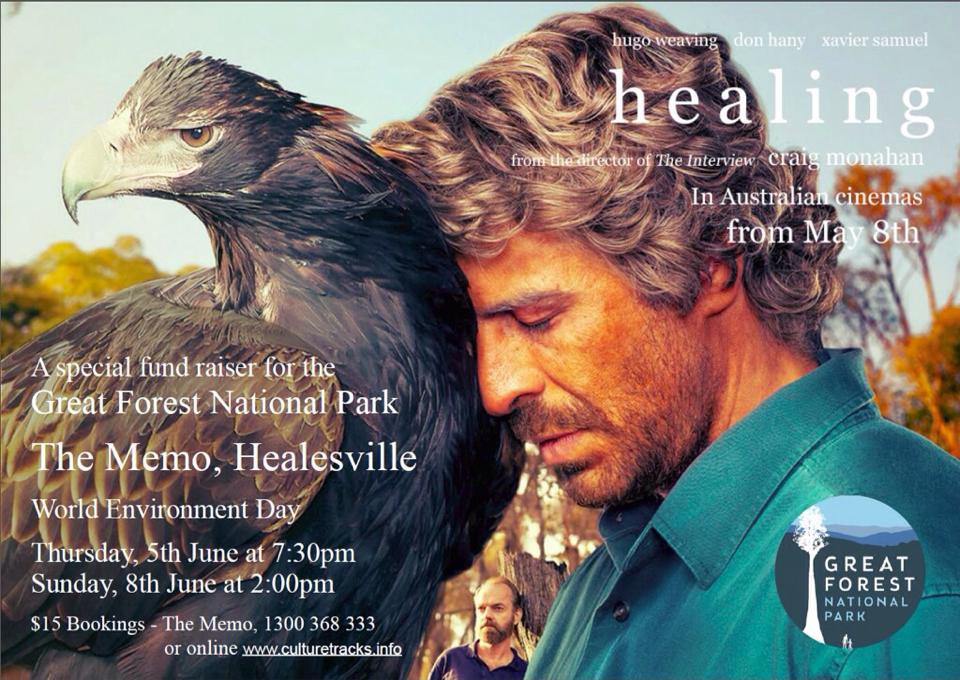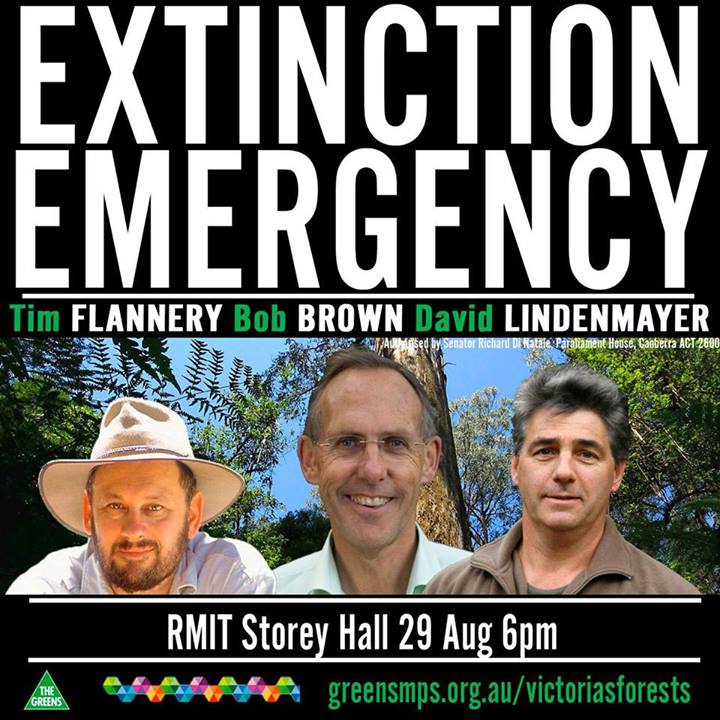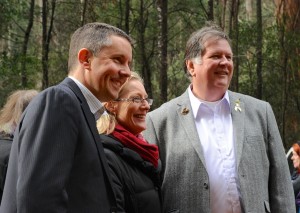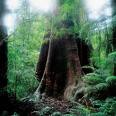Home
‘Healing’ movie screening: Thursday June 5 & Sunday June 8, ‘The Memo’ Healesville
Want to show your support for the proposed Great Forest NP? Here’s a great fundraiser…
Two special showings of “Healing” at Healesville’s Memo Hall!!
Thurs 5th 7:30pm & Sun 8th 2:00pm June
About Leadbeater’s Possum
Leadbeater’s Possums can be viewed at Healesville Sanctuary in its nocurnal enclosure.
Leadbeater’s Possum was presumed extinct by 1960 simply because no live specimen had been seen for 50 years. Then, in 1961, a single possum was rediscovered by naturalist Eric Wilkinson near Marysville, 90 minutes east of Melbourne – a far cry from its original known habitat in Gippsland. Previously, the last captured Leadbeater’s Possum was from 1909.
Since it’s rediscovery a great deal of interest, research and awareness has been raised by Victoria’s zoos, biologists, community groups and citizens. In 1968 it was made the official faunal emblem of Victoria.
Also known as Fairy Possum, the Leadbeater’s Possum is a tiny, nocturnal creature with large eyes and a long tail measuring around 10 to 15cm in length. It requires old growth eucalypt trees with established hollows for its home. As a result it is now located in small pockets of old growth Mountain Ash forest in Victoria’s Central Highlands from Toolangi, near Kinglake, to Powelltown, near Warburton.
Leadbeater’s Possum numbers are estimated to have peaked in the mid-1980s, when approximately 7500 were known in the wild. From then, it’s numbers have declined. Logging has impacted on its habitat and range. Devastatingly, the Black Saturday bushfires of 2009 burned around 45% of its remaining habitat. There is now estimated to be around 1500 Leadbeater’s Possums remaining and it may soon be admitted to the critically endangered list. Since 2009 there has been renewed scientific and community interest.
A breeding program at Healesville Sanctuary is hopeful of seeing results in the near future and understanding more about Leadbeater’s socialization and habits. Various community groups, including Friends of Leadbeater’s Possum, My Environment and Great Forest National Park continue to champion for Victoria’s fairy possum and liaise with both government and industry to create a safe haven.
There is hope that some time soon a national park will be established that will provide Leadbeater’s possum with a more stable future.
We celebrate Leadbeater’s possum in 2014 and trust you will too.
Submissions are now open for the public to comment on the uplisting of LBPs to Critically Endangered
Open for comment until 24 January 2014.
Stagwatching Volunteering Opportunities Â
Visit the Volunteer page to read how you can become involved in the 2014 Summer Stagwatching Program with the world renowned ANU research team who have been studying Leadbeater’s Possums and the Central Highlands forests for over 30 years!!
Leadbeater’s Possum Advisory Group (LPAG)Â
The LPAG has been established by the Victorian Government to develop recommendations for consideration aimed at supporting the recovery of LBPs (while maintaining a “sustainable” timber industry). A final report will be submitted to government in late 2013. The Victorian Government has allocated $1m to this process.
Friends of Leadbeater’s Possum (represented by Pam Miskin and Steve Meacher) was involved in a half day workshop with LPAG and Community representatives to hear the latest science from Dr Lindy Lumsden (Arthur Rylah Institute), Dr Dan Harley (ZoosVic) and Professor David Lindenmayer (ANU). There were four separate workshops held over 2 days at the Sofitel in Melbourne. The first day was for Scientists and Environmental NGOs, and the second day was for Industry and Community. At the workshop we were all asked to list our top priorities to help save LBPs from extinction and these will be collated by LPAG for consideration.
Post Script: The Leadbeater’s Possum Recovery Team has been prevented (gagged by government) from commenting on the recommendations to the state government. The LPAG has refused to release their recommendations to the Recovery Team saying that they are ‘confidential’ – the process doesn’t really seem transparent does it?
You can watch the three presentations here:Â http://www.depi.vic.gov.au/environment-and-wildlife/wildlife/leadbeaters-possum
Visit while you can
Great Forest National Park – Letter Writing Campaign
Visit the Latest News page for an article by Prof Lindenmayer describing his vision for the GFNP …
Please show your support for this wonderful initiative to save Leadbeater’s Possum from extinction, by writing to the Napthine State government and the new Federal government expressing your views on the proposal.
Visit: www.greatforestnationalpark.com.auÂ
Please email or write to the Ministers below, expressing your own views on the Great Forest National Park and include personal photos of the area if you have them.
Click on the link to obtain email and website details for each Minister:
| Premier of Victoria | The Hon. Dr Denis Napthine, MP | 03 9651 5000 |
| Deputy Premier of Victoria | The Hon. Peter Ryan, MP | 03 9651 1222 |
| Minister for Environment and Climate Change | The Hon. Ryan Smith, MP | 03 9637 8890 |
Park Watch article on the new national park proposal:
http://issuu.com/vnpa/docs/park_watch_september_2013_-_no_254/13?e=1929092/4880087
 Video coverage of the Extinction Emergency forum can be downloaded here:
http://www.youtube.com/watch?v=bnXX1moqj_U&sns=em
Leadbeater’s Possum – Fighting for its survival
Radio broadcast from 3CR aired on Sunday 25th August featuring three interviews:
Dr Dan Harley, Threatened Species Biologist, Zoos Victoria
Pam Miskin, President, Friends of Leadbeater’s Possum Inc
Sarah Rees, Executive Director, MyEnvironment
http://www.freedomofspecies.org/show/leadbeaters-possum-fighting-its-survivalÂ
Insight: Recovering a Great Forest
Mark Colvin ABC Radio, 13th August 2013
The leading expert on Victoria’s faunal emblem, the Leadbeater’s Possum, says the creature faces certain extinction if Victorian and Federal Governments don’t take urgent action.
Professor David Lindenmayer of the ANU says one thing that’s absolutely essential is the creation of a new Great Forest National Park, protected from logging, in the mountain forests east of Melbourne.
Listen to the interview or download the transcript here: http://mobile.abc.net.au/news/2013-08-13/new-national-park-proposal-to-save-the-leadbeaters/4884744
Â
The Victorian Government declined to comment on the interview and referred PM to VAFI instead. Visit our Latest News page to read a transcript of the interview with Lisa Marty from VAFI.Â
Kalatha Giant Tree – Official Opening on National Tree Day!
The First Elizabethâs reign was over and James of Scotland ruled England as James I. James Cookâs birth was still more than a century away. Shakespeareâs famous Globe Theatre had recently burned down after a cannon misfired during a performance. Around this time, four hundred years ago, there was forest fire in a mountain range on the other side of the globe, not far from the southern edge of a land-mass that would later be called Australia.
Probably ignited by lightening, the fire burned through part of the Mountain Ash forest that cloaked these hills. It burned across a number of ridges, jumping the moist, sheltered rainforests in the deepest gullies and soon burned itself out, extinguished by the dampness of the montane forest itself.
Mountain Ash trees are fire sensitive. But before European settlement natural fires occurred in patches, clearing the way for new generations and shaping the landscape. The massive trunks didnât burn and remained standing, bleached sentinels overlooking the blackened hillsides. After the fire, the dead trees began to release the precious store of seeds from their capsules, almost 100 metres above the ground. The tiny seeds rained down to the ground in millions. They contained little food for the embryos inside so the germinating trees had to quickly grow their first leaves, to produce their own supply. Like all green plants they used energy from the sun to turn carbon dioxide and water into sugar. The fire had destroyed most of the other plants covering the ground but they still had to compete with each other for sunlight and the rainwater which fell on the mountains from the clouds cooling above the ranges.
To overcome the intense competition the seedlings grew rapidly, around a metre a year. Many were unable to maintain the frantic rate of growth and by the time Samuel Pepys started scribbling his diary by candlelight on the other side of the world, the density of trees had thinned. The survivors were already 60 metres tall and had outstripped all competition from the other species of plants that had grown to form an understorey far below.
Nor were the trees at risk from the people who visited the area from time to time and called it âKalathaâ. The Taungurung people from the north and the Wurrundjeri people from the south, members of the Kulin Nations, visited the montane forests to collect mulberry stems, which made good spears and fire sticks, to gather the delicious, starchy pith from tree-fern stems and to hunt possums and wallabies.
By the time Captain James Cook landed at a bay he called âBotanyâ, far to the east, the Mountain Ash trees at Kalatha were already in their prime, around 80 metres tall. Some probably topped 100 metres. Because of their enormous height, and dominance over the landscape they inhabited, when European botanists first described the species and gave it a scientific name they called it âEucalyptus regnansâ â reigning eucalypt.
But like that of any human monarch, the reign of a Mountain Ash tree eventually passes. Without any pumping mechanism (like an animalâs heart) a tree as tall as Mountain Ash always lives on the edge of survival. Itâs a constant struggle to draw enough water up from its roots to its topmost boughs. The crown of the tree can be suffering drought, even when the ground below is damp. Eventually the top of the tree dies and breaks off allowing the trunk to
decay down the centre. When the species was named âregnansâ, a century after Cookâs first arrival, the reigning trees at Kalatha were in decline.
A few decades later around the turn of the 20th Century the first Europeans arrived at Kalatha. Many of the big Mountain Ash on the hillside were felled by timber-getters to be split into palings and shingles for the growing city of Melbourne. Massive stumps were left with slots in the sides where the axe-men had stood on planks to cut the trees above the buttressed base. Some of these stumps can still be seen today, still slowly rotting away. But some big trees were spared the axe. Perhaps they had been damaged by fires, such as the âBlack Thursdayâ bushfires of 1851, which burned a quarter of Victoria. Or maybe they were just too rotten inside to justify the hard effort of cutting them down by hand. Maybe they were too awesome to destroy.
One of the largest of these remaining trees is now known as the âKalatha Giantâ. Its top broke off long ago and itâs rotten right down the centre of its trunk. But it remains alive. It has survived several major fires in its lifetime. One of the fires damaged the tree, creating a âCathedral doorâ fire-scar, formed when a heap of debris at the foot of the tree continued to burn after the fire had passed. As the tree survived despite the damage, bark eventually grew back around the scar, forming the classic Gothic arch shape. The Kalatha Giant also survived the logging that took many of the trees that had germinated around it so many centuries ago. The immediate area around the tree is now protected.
After the Black Saturday bushfires of 2009, the Toolangi and Castella community proposed to construct a walk to the Kalatha Giant, to both celebrate and protect this special tree. A walk would allow members of the community to visit the tree and to be inspired by its size, its age and its history of resilience and survival. The project was funded by the Victorian Bushfires Appeal Fund. The Kalatha Giant Tree Walk at Kalatha Creek, Toolangi State Forest was declared open by the federal Minister for the Environment, the Hon. Mark Butler, on 28th July, National Tree Day.
Visit the Kalatha Giant soon â and be inspired!
Steve Meacher
 Monday 24 June 2013    Â
Victorian Supreme Court of Appeal
MyEnvironment -v- VicForests
Presiding: Hon. Chief Justice Warren, Justice Tate and Justice Garde
 We have weathered the appeal in the Supreme Court today and are quite happy with the way it went.
The panel of the Hon. Chief Justice Marilyn Warren, Justice Tate and Justice Garde had obviously studied the trial material and asked apposite and penetrating questions of both sides which Julian Burnside QC (for MyEnvironment) handled with wit and aplomb. Having come to the case since the trial, his knowledge of the files was impressive!
At 4:02 pm submissions were complete and the case was adjourned Sine die. We don’t know how long we will have to wait for a judgement but it could be several weeks at least. And we may not get a lot of notice, so stay tuned.
Many thanks to the Knitting Nannas of Toolangi, TWS, EDO and all of you who joined us in the Red Court today, the fact that we completely filled the room (and some) sends a strong message. And thanks also to the very many of you who sent messages of good wishes – it’s all appreciated.
Visit: www.myenvironment.net.au  to learn more about this vital case and consider making a donation towards the fund to fight for the survival of Leadbeater’s Possum!
Leadbeaterâs Possum Awareness Week 2013 – a Great Success!

Picture: JAY TOWN. Copyright.
The inaugural LBP Awareness Week (1-7 April) achieved its aim this year to highlight the current plight of our state faunal emblem. Thanks must go to the hard working FLBP Committee and MyEnvironment staff for pulling together to make the week a success.
Media from Leadbeater’s Possum Awareness Week
The Herald Sun newspaper (5th April, page 15) took some stunning photos of a captive LBP at Healesville Sanctuary, which will be uploaded to our website soon – thanks to the support of Judy Robertson (Communications Manager at ZoosVic) for facilitating this publicity and obtaining the rights to reproduce the photos. They selected one photo for publication and Sophie Aubrey wrote an informative article about the possums history, the captive breeding program and included our website at the bottom.
Unfortunately it is not online, only available in hard copy.

Picture:Â In the right hands:Â A Leadbeaterâs possum at Healesville Sanctuary which is working to save the species. Picture: JAY TOWN. Copyright.
The Age newspaper on Tuesday 9th April featured an article by their Environment Reporter Tom Arup which focussed on the withdrawal of the proposed changes by DSE to the Forest Code of Practice which would have further impacted on LBPs and other threatened species. You can read the article here…
http://www.theage.com.au/victoria/fears-for-leadbeaters-possum-20130408-2hhde.html
Cambarville Event for Leadbeater’s Possum Awareness Week
On Saturday 6th April over 50 people gathered at Cambarville Picnic Ground to celebrate the launch of our annual LBP Awareness Week (and the possums rediscovery on 3rd April 1961). We began the afternoon with a short talk from Mr Eric Wilkinson who shared his story of the incredible rediscovery of Leadbeaterâs Possum – including the first photo taken of them in the Central Highlands. His recollections were wonderful to hear and we are looking forward to reading them one day in the near future!

Picture: FLBP President; Pam Miskin, Mr Eric Wilkinson and Cr Sam Dunn.
Australia National University Research Officer Dave Blair (and son Leo!) took us on a fascinating and informative Walk ânâ Talk for a couple of hours through the forests at Cambarville, highlighting the differences in fire severity impact upon the regeneration and the Leadbeaterâs Possums themselves. Dave is employed by Professor David Lindenmayer to monitor the Central Highlands forests and their wildlife as part of his ongoing 30+ year study. It is the longest continual ecological study in the world. He showed us some beautiful 250+ year old mountain ash trees and described how important the hollows and crevices in all trees both living and dead are for the possums.
As we all know these important dead stags when left in logging coupes as habitat trees become victims of the high intensity regeneration burns and disintegrate leaving nothing but charcoal on the ground. Live trees left in the coupes as habitat trees are killed by the 1200âC fires and so too are condemned to collapse in the future. No Leadbeaterâs Possums have been found in any areas of 2009 burnt forest – they are extremely sensitive to disturbance – logging and fire.

Picture: Dave Blair leads the enthusiastic group of possum people through the forests.
Unfortunately, despite being told of our event, DSE decided to go ahead and ignite three logging coupes within quite close proximity of Cambarville.
However, the âupsideâ of all that smoke was that a reporter from the UK newspaper The Guardian was there to witness and write about it all! The article on Leadbeater’s Possums was published online on 27 May 2013 – the launch day of the newspaper in Australia!
http://www.guardian.co.uk/environment/2013/may/26/logging-pushing-possum-towards-extinction Â
It was an afternoon filled with enthusiasm for the environment and Leadbeaterâs Possums in particular – but it left a group of like minded Victorians wondering how it has been allowed to come to the point where we are witnessing the rapid slide to extinction of our state emblem… and what it will take to stop that from happening.
YOU CAN HELP LEADBEATERâS POSSUMS NOW!
The Age article is the first of several stories we will need to prompt Minister Mark Butler to act – he’s moving, but clearly needs the extra impetus.  Everyone needs to get to their friends and colleagues to write a letter to The Age. Not just today, keep them flowing from here on. This is how we can put the pressure on the powers that be.
Politicians NEED TO SEE LETTERS!
http://www.theage.com.au/national/letters/submitletters@theage.com.au
Suggested topics:
1. Come out with the recent Victorian government LBP survey findings Ministers Walsh/Smith! This is NOT enough to secure species.
2. It has taken DSE 6 months to write survey standards to permit logging and 6 years to review an Action Statement that controls logging – still being stalled.
3. Big Tree Crisis, we can’t waste time… old habitat trees are being lost to logging and burning, 150 years before it becomes useful to LBPs. VicForests is destroying 45% of retained habitat of ash forest logging coupes (VicForests AFS Audit 2012)
4. Stalling saves Reflex paper’s future but reduces our faunal emblem’s future.
5. Not acting is sanctioning extinction! We have 30 years of science to underpin what needs to be done!
6. Our forests and wildlife have not been allowed to recuperate since Black Saturday – try and mention the fires.
7.  Loggers have had millions of taxpayers dollars in grants and broad access to these damaged forests. Unchecked they have now OVER-LOGGED the mountain ash forests.
8. This matters to the people of Victoria – where is Tony Burke?
9. How can this species be allowed to go extinct under the EPBC Act? It means the Regional Forestry Agreements are failing the nation’s forests.
10. We need Direct Action on wildlife NOW!
And many more reasons……
You are all creative, just keep the letters going, for weeks if we must. The newspaper editors will appreciate the passion.
ALWAYS make reference to a politician – it is their fault this species is going extinct.
Pick and choose and add your own ideas.
Denis Napthine
Peter Walsh
Ryan Smith
Cindy McLeish
Tony Smith
Greg Hunt
Daniel Andrews
Tony Abbott
Friends of Leadbeater’s Possum information brochure
Click on the link to open the file: Â Â FLb P flyer Dec 2012, reduced calibri copy
Their future is in our hands…
Leadbeater’s Possum is Victoria’s State Faunal emblem. An endangered species with both State and National Recovery Programs in place. Endemic to Victoria, they exist nowhere else but the Central Highlands forests, Yellingbo Nature Conservation Reserve and alpine areas between Lake Mountain & Mt. Baw Baw.
Population estimates prior to the 2009 bushfires were around 2,000-2,500 individuals, post-fire estimates are <1,000. Approximately 40-50% of their prime habitat was lost in the fires.
We are Friends of Leadbeater’s Possum Inc. Established in 2004 to give a voice to these amazing but elusive forest animals. Leadbeater’s Possum habitat has many impacts ranging from timber harvesting (including salvage logging) to bushfire and bushfire prevention methods like fuel breaks and fuel reduction burning.
Together we hope to be able to help Leadbeater’s survive in the wild by encouraging conservation efforts, research programs and effective conservation strategies and policies.












